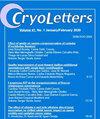Interactions among sucrose and concentrations of serum fetal bovine on the cryopreservation of somatic cells derived from red-rumped agoutis.
IF 1
4区 生物学
Q3 BIOLOGY
引用次数: 0
Abstract
BACKGROUND The synergistic action among the different extracellular cryoprotectants could improve somatic cell quality after thawing and provide bases for the formation of biobanks for red-rumped agoutis. OBJECTIVE This study evaluated the interactions among sucrose (SUC) and concentrations of serum fetal bovine (FBS) on the cryopreservation of somatic cells derived from red-rumped agoutis. MATERIALS AND METHODS Cells were cryopreserved with 10% dimethyl sulfoxide and different concentrations of FBS (10%, 40%, and 90%) with or without 0.2 M SUC, totaling six comparison groups. Non-cryopreserved cells were used as a control. Cells were evaluated for viability, metabolic activity, proliferative activity, reactive oxygen species (ROS), mitochondrial membrane potential and apoptosis levels. RESULTS No difference was observed among cryopreserved with DMSO containing (10FBS, 10FBS-SUC, 40FBS, 40FBS-SUC, 90FBS, 90FBS-SUC) and non-cryopreserved groups for viability, metabolic activity, proliferative activity, and ROS levels. Interestingly, only cells cryopreserved with 90% FBS and SUC maintained the mitochondrial membrane potential like the control. This indicates that at high concentrations of FBS, SUC contributes to the maintenance of this parameter in cryopreserved cells. Moreover, at concentrations of 10% and 40% of FBS, SUC contributed to the maintenance of viability evaluated by the levels of apoptosis evaluated after thawing. In summary, we verified that 90% FBS and 0.2 M SUC promote greater ability of cells after thawing. Additionally, SUC positively acts in cryopreservation solutions containing 10% and 40% FBS. CONCLUSION This information is essential to an understanding of the mechanisms involved in the interactions of extracellular cryoprotectants in somatic cell cryopreservation solutions of red-rumped agoutis. DOI: 10.54680/fr23210110212.蔗糖和胎牛血清浓度对红臀鼠体细胞冷冻保存的相互作用。
不同细胞外冷冻保护剂之间的协同作用可以提高解冻后体细胞的质量,为红背刺生物库的形成提供基础。目的探讨蔗糖(SUC)和胎牛血清(FBS)浓度对红臀田鼠体细胞冷冻保存的影响。材料与方法将细胞用10%二甲亚砜和不同浓度(10%、40%、90%)含或不含0.2 M SUC的胎牛血清冷冻保存,共6组。非冷冻保存细胞作为对照。评估细胞活力、代谢活性、增殖活性、活性氧(ROS)、线粒体膜电位和凋亡水平。结果DMSO低温保存组(10FBS、10FBS- suc、40FBS、40FBS- suc、90FBS、90FBS- suc)的细胞活力、代谢活性、增殖活性和ROS水平与非低温保存组无显著差异。有趣的是,只有含有90% FBS和SUC的细胞与对照组一样保持线粒体膜电位。这表明,在高浓度的FBS下,SUC有助于低温保存细胞中该参数的维持。此外,在FBS浓度为10%和40%时,通过解冻后的细胞凋亡水平评估,SUC有助于维持细胞活力。综上所述,我们验证了90%的FBS和0.2 M的SUC在解冻后促进了细胞更大的能力。此外,SUC在含有10%和40% FBS的冷冻保存溶液中发挥积极作用。结论这一信息对于了解细胞外冷冻保护剂在红背田鼠体细胞冷冻保存液中相互作用的机制至关重要。DOI: 10.54680 / fr23210110212。
本文章由计算机程序翻译,如有差异,请以英文原文为准。
求助全文
约1分钟内获得全文
求助全文
来源期刊

Cryo letters
生物-生理学
CiteScore
1.80
自引率
10.00%
发文量
50
审稿时长
1 months
期刊介绍:
A bimonthly international journal for low temperature sciences, including cryobiology, cryopreservation or vitrification of cells and tissues, chemical and physical aspects of freezing and drying, and studies involving ecology of cold environments, and cold adaptation
The journal publishes original research reports, authoritative reviews, technical developments and commissioned book reviews of studies of the effects produced by low temperatures on a wide variety of scientific and technical processes, or those involving low temperature techniques in the investigation of physical, chemical, biological and ecological problems.
 求助内容:
求助内容: 应助结果提醒方式:
应助结果提醒方式:


